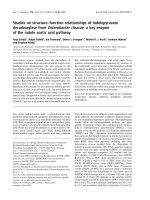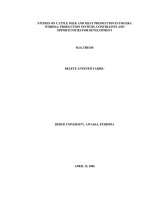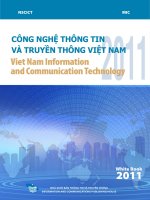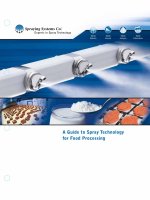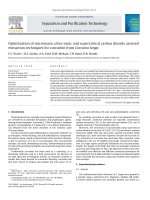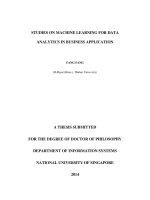Studies on cellulase-ultrasonic assisted extraction technology for flavonoids from Illicium verum residues
Bạn đang xem bản rút gọn của tài liệu. Xem và tải ngay bản đầy đủ của tài liệu tại đây (2.48 MB, 9 trang )
Huang et al. Chemistry Central Journal
DOI 10.1186/s13065-016-0202-z
(2016) 10:56
Open Access
METHODOLOGY
Studies on cellulase‑ultrasonic
assisted extraction technology for flavonoids
from Illicium verum residues
Danna Huang1†, Xiaolei Zhou1,2†, Jianzhi Si1, Xiaomei Gong1,3 and Shuo Wang1,3*
Abstract
Background: Illicium verum is widely cultivated in southern China especially in Guangxi province. Its fruits has been
traditionally used in Chinese medicine. In recent years, it has been the industrial source of shikimic acid. Usually the
residues after extracting shikimic acid are treated as waste. Thus, the aim of this study was to optimize the extraction
conditions of cellulase-ultrasonic assisted extraction technology for flavonoids from I. verum residues.
Results: The optimum extraction conditions with a maximum flavonoids yield of 14.76 % are as follows: the concentration of ethanol is 51.14 %, the liquid–solid ratio is 20.52 mL/g, the enzymatic hydrolysis pH is 5.303, the sonication time is 60 min, the enzyme solution temperature is kept at 45 °C, the amount of added enzyme is 70 mg/g, the
enzymatic hydrolysis time is 2 h and the crushed mesh size is 0.355–0.85 mm.
Conclusions: The data indicate that the cellulase-ultrasonic assisted extraction technology has the potential be used
for the industrial production of flavonoids from I. verum.
Keywords: Cellulase-ultrasonic, Extraction, Flavonoid, Illicium verum
Background
Illicium verum Hook. f., known as Chinese star anise, is a
magnoliaceae evergreen arbor plant that grows mainly in
Southwest China, especially in the provinces of Guangxi,
Guangdong, Yunnan and Fujian. China is already the
world’s largest producer of I. verum, with its cultivation
as a medicinal plant in the Guangxi province accounting for approximately 90 % of the total output [1–3].
As a kind of popular cooking spice, the dried fruits of I.
verum have also been used traditionally in Chinese medicines. In 2002, I. verum was categorized as both food and
medicine by the Ministry of Health, People’s Republic of
China and it is listed in the Chinese Pharmacopoeia with
the actions of warming yang and dispelling cold, and
regulating the flow of Qi to relieve pain [4–6]. The most
valuable part of I. verum is the essential oil extracted
*Correspondence:
†
Danna Huang and Xiaolei Zhou contributed equally to this work
1
Guangxi Botanical Garden of Medicinal Plants, Nanning 530023,
People’s Republic of China
Full list of author information is available at the end of the article
from it which has a wide range of commercial applications including the production of perfumes, cosmetics,
soaps, foods and beverage flavoring [7, 8]. Furthermore,
I. verum is the industrial source of shikimic acid, a key
intermediate used in the production of Tamiflu, which is
a well-known antiviral drug and has recently been used
to reduce the effects of bird flu [9]. I. verum has also been
reported to possess antioxidant and antimicrobial activities due to its high concentrations of phenol compounds,
and it is known that flavonoids also play an important
role in this regard [10–12].
Medicinal plant material is used in a large number of
phytopharmaceutical industries but the growing demand
for these medicines means that the medicinal plant
sources might no longer be capable of providing enough
material in the future. However, the rich extracts from
the I. verum biomass have traditionally been considered
as waste because of inefficient extraction and separation processes [3], and usually the residues are treated
as waste. A great number of innovative extraction methods such as ultrasound-assisted extraction, supercritical
© 2016 The Author(s). This article is distributed under the terms of the Creative Commons Attribution 4.0 International License
( which permits unrestricted use, distribution, and reproduction in any medium,
provided you give appropriate credit to the original author(s) and the source, provide a link to the Creative Commons license,
and indicate if changes were made. The Creative Commons Public Domain Dedication waiver ( />publicdomain/zero/1.0/) applies to the data made available in this article, unless otherwise stated.
Huang et al. Chemistry Central Journal
(2016) 10:56
fluid extraction, extrusion and microwave extraction are
now employed in the food industry [8]. Enzyme-assisted
extraction is a mild, efficient and environmental friendly
extraction method and it has been adopted for extracting various kinds of compounds recently [13]. The ultrasound-assisted extraction technique causes collapse of
cavitation bubbles which generates sufficient energy to
give rise to collisions between suspended plant particles
for accelerating the release, diffusion and dissolution of
active substances in the cell. On the other hand, enzymeassisted extraction uses enzyme preparations either alone
or in mixtures that catalyze hydrolysis of the cytoderm
and glycoproteins, and enhance the release of bioactive
substances by disrupting plant cells [14]. Enzymolysisultrasonic assisted extraction is a combined extraction
method, which has advantages of the two extraction
methods such as mild extraction conditions, lower
investment costs and energy requirements, and simplified manipulation [15].
Recently, response surface methodology (RSM), which
is a statistical technique to determine the influences of
individual factors and their interactive influences, has
been used increasingly to optimize processing parameters [8, 16–18]. In some previous reports, the optimization studies on enzymolysis-ultrasonic assisted
extraction of Cucurbita moschata, Lycium barbarum,
Momordica charabtia, wheat bran and corn silk have
been performed using RSM [13–15, 19, 20]. Hence, the
cellulase-ultrasonic assisted extraction technology for flavonoids from plants, combining the mild bio-enzymatic
hydrolysis conditions and the rapid ultrasonic extraction
technology, will protect the maximum bio-activity of the
flavonoids. In this paper, we studied the optimization of
cellulase-ultrasonic assisted extraction for flavonoids
from I. verum residues using response surface methodology. The adsorption conditions were optimized from a
single factor and orthogonal design experiments and desorption conditions were optimized from dynamic desorption experiments.
Experimental
Materials
The dried fruits of I. verum Hook. f. were collected from
Baise County, Guangxi, China. A voucher specimen
of this material was deposited in the herbarium of the
Guangxi Botanical Garden of Medicinal Plants.
Cellulase was purchased from Sigma Company (USA,
No. SC118401). Rutin used as the control was obtained
from Sinopharm Chemical Reagent Co., Ltd (China,
No. U1606503). Ethanol, methanol, petroleum ether
were bought from Guangdong Xilong Chemical Factory
(China). Hydrochloric acid was from Shanghai Ailian
Chemical Reagent Company (China) and sulfuric acid
Page 2 of 9
was from Tianjing Qingfa Chemical Factory. Other reagents used in the experiments were purchased from Sinopharm Chemical Reagent Co., Ltd (China).
Methodologies
Sample preparation
1 kg dried plant materials was powdered with a mill (Fz02, Zhejiang Baile Mill Factory). After drying at 60 °C for
12 h, 0.9 kg of crushed material was used for extracting
shikimic acid by a water extraction method [21], and then
the residues were degreased and decolorized in petroleum ether with a ratio of 1:3 (m/v) at 60 °C, and carried
on a backflow for 4 h. Subsequently, the residue product
was dried at 60 °C for 48 h and weighed, then stored in a
desiccator in order to maintain a constant weight for use
in the subsequent experiments. The weight of the residue
product was 0.8865 kg, which accounted for 98.5 % of the
raw crushed materials.
Identification of flavonoids
An appropriate amount of the prepared samples
was reflux with 80 % ethanol at a solid liquid ratio of
1:10 (m/v) at 80 °C for 2 h. The ethanol solution was concentrated by reducing the pressure and dried by vacuum.
The total flavonoid extracts obtained were dissolved in
methanol and then tested using the HCl–Mg reaction
and the aluminum chloride colorimetric methods. The
extracts responded positively to these characteristic color
reactions for flavonoids.
Standard curve preparation
5.0 mg of rutin was dissolved in 60 % ethanol to a concentration of 0.2 mg/mL for use as the rutin standard
solution. A set of standard solutions containing 0, 0.08,
0.16, 0.24, 0.32, 0.4 and 0.48 mg of rutin were made up
in a total of 5 mL of 60 % ethanol. 0.4 mL of 5 % NaNO2
solution was added to each tube, which was incubated
and shaken for 6 min, and then 0.4 mL of 5 % Al(NO3)3
solution was added and shaken for a further 6 min. 4 mL
of 4 % NaOH solution was added and this was made up to
10 mL with 60 % ethanol. After incubation for 15 min, the
rutin standard solutions with extracted flavonoids were
developed by addition of a Na2NO2–Al(NO3)3–NaOH
coloration system. This was the read at the wavelength
range of 200–700 nm on an ultraviolet spectrophotometer. The absorbance was measured at 500 nm which is the
selected maximum absorption wavelength and a standard curve was created.
Determination of optimum conditions for extraction
of flavonoids
1.000 g of the prepared residue samples was soaked with
5 mL cellulose in a 50 mL centrifuge tube and citrate
(2016) 10:56
buffer was used to adjust pH. The enzymatic hydrolysis
was conducted at a constant temperature and pH for several hours. After inactivating the cellulose at 100 °C for
5 min, 15 mL ethanol was added and the mixture was
subjected to ultrasonic treatment. The extraction process
was designed with these corresponding conditions. Using
the following conditions of 10 mg/mL cellulase, 50 %
ethanol, a mesh size of 0.355–0.85 mm, 2 h of enzymatic
hydrolysis at pH 5, a liquid–solid ratio of 20:1, 60 min
of sonication time and 40 °C, extraction temperature,
the extraction yield of flavonoids from the I. verum residues was determined. Each of the parameters was kept
as above while the others were varied as follows: cellulase concentrations (2, 6, 10, 14 and 18 mg/mL), ethanol
concentrations (10, 15, 20, 25, 30 and 50 %), mesh sizes
(0.85–2.0, 0.355–0.85, 0.25–0.355 and 0.18–0.25 mm),
enzymatic hydrolysis times (0.5, 1, 1.5, 2, 2.5 and 3 h),
pH (3, 4, 5, 6 and 7), different liquid–solid ratios (5:1,
10:1, 15:1, 20:1, 25:1 and 30:1), sonication times (15, 30,
45, 60, 75 and 90 min) and extraction temperatures (35,
40, 45, 50, 55, 60 and 65 °C). All tests were carried out in
triplicate.
Response surface optimization design
Determination of main experimental factors
On the basis of the single factor determinations of
extraction experiments, we selected a set of experimental factors. The main experimental factors were further
subjected to selection by the Plackett–Burman design in
order to simplify the subsequent response surface experimental design.
Optimization by Box–Benhnken design
According to the principles of the Box–Benhnken design,
the main experimental factors that affect the extraction
process of flavonoids from residues of I. verum samples
were optimized and the response surface analysis was
carried out. The relationship between the extraction yield
and each factor was established.
Data analysis
Results were analyzed in triplicate and expressed as
mean ± standard deviation. The data were analyzed by
DPS statistical software and p < 0.05 was considered to
be statistically significant.
Results and discussion
Standard curve and regression equation
The absorbance was measured at the wavelength of
500 nm and the standard curve of rutin is shown in
Fig. 1. Using the linear least square approach, the regression equation between the concentration and absorbance of rutin standard solutions was obtained as,
Page 3 of 9
0.6
y = 11.402x + 0.00536
R² = 0.9995
0.5
Absorbance
Huang et al. Chemistry Central Journal
0.4
0.3
0.2
0.1
0
0
0.01
0.02
0.03
0.04
0.05
0.06
Rutin concentration (mg/mL)
Fig. 1 Standard curve
A = 11.402C + 0.00536 (R2 = 0.9995). Its linear range is
from 0.008 to 0.048 mg/mL. The linear calibration was
performed to enable quantification of the flavonoids. The
extraction yield of flavonoids from the samples was calculated as the percentage of the content according to the
following equation:
Extraction yield (%) =
C ×V
× 100 %
m
where A is absorbance, C is concentration of flavonoids
(mg/mL), V is volume of solution (mL), and m is content
of the test sample (mg).
Single factor experiment
Effect of sonication time on the extraction yield
Starting from 15 min, the extraction yield increased with
an increase of sonication time and reached the maximum
value of 11.16 % at 60 min, and then it decreased gradually (Fig. 2). This may be due to low stability of some flavonoids which degraded due to ultrasonic heat effects,
and may further result in destruction of their basic
structures. The optimum ultrasonic processing time for
extracting the flavonoids was determined to be 60 min.
Effect of liquid–solid ratio on the extraction yield
Figure 3 reveals that the extraction yield of flavonoids
was raised with an increased amount of the extracting agent initially from 5 mL and reached the maximum
value of 14.63 % at the liquid–solid ratio of 20:1 after
which it levelled off. When the liquid–solid ratio was too
low, the flavonoids cannot be extracted adequately from
the lysed cells. However, when ratio is too high, this will
weaken the effect of ultrasonic waves on the fragmentation of the sample. Therefore, the liquid–solid ratio of
20:1 was selected.
Effect of ethanol concentration on the extraction yield
The effect of ethanol on flavonoids extraction was investigated from 30 to 80 %. It is seen in Fig. 4 that different
Huang et al. Chemistry Central Journal
(2016) 10:56
Page 4 of 9
17
Extrction yeild (%)
15
13
11
9
7
5
0
15
30
45
60
75
90
105
Sonication time (min)
Fig. 2 The effect of sonication times on the extraction yield of
flavonoids
Effect of enzymatic hydrolysis pH on the extraction yield
Figure 5 shows that in the range of pH from 3 to 7, the
extraction yield was raised below pH 5 and reached the
maximum extraction yield of 15.42 % at pH 5 and then it
declined as it neared a neutral pH. This can be explained
by the fact that the enzymatic hydrolysis pH had an effect
on the cell wall with respect to the hydrolysis of cellulase.
Reaction conditions with too much acid or alkali will lead
to a loss of biological enzyme activity, and also increase
the loss of other non-flavonoids ingredients, so those
conditions are not conducive to the extraction of the target components.
17
15
Extrction yeild (%)
concentrations of ethanol have an impact on the flavonoids extraction yield. Low or high concentrations of
ethanol are not conducive to the optimum extraction
and this is related to the type of flavonoids present in the
sample. The flavonoid glycoside components with less
polar portions are soluble in ethanol, however, those that
are more polar are soluble in water. So when the ethanol
concentration reaches the correct proportion, the total
flavonoids extraction yield reached the highest value. The
experimental results showed that 50 % ethanol was the
optimal concentration to extract the flavonoids from the
samples.
13
11
9
Effect of extraction temperature on the extraction yield
7
5
0
5
10
15
20
25
30
35
Liquid-solid ratio (mL/g)
Fig. 3 The effect of liquid–solid ratios on the extraction yield of
flavonoids
Fig. 4 The effect of ethanol concentrations on the extraction yield of
flavonoids
Figure 6 shows that from 35 to 45 °C, the flavonoids
extraction yield increased with a rise of the enzymatic
extraction temperature, and the peak yield (15.73 %) was
reached at an extraction temperature of 45 °C. When the
extraction temperature was higher than 45 °C, the extraction yield kept on decreasing due to the fact that the high
extraction temperature always resulted in an increase of
Fig. 5 The effect of pH on the extraction yield of flavonoids
Huang et al. Chemistry Central Journal
(2016) 10:56
Fig. 6 The effect of temperatures on the extraction yield of flavonoids
Page 5 of 9
Fig. 8 The effect of times of enzymatic hydrolysis on the extraction
yield of flavonoids
enzyme activity [19, 20]. Therefore, it can be considered
that the optimum reaction temperature for enzymatic
hydrolysis of the cell wall of I. verum is at 45 °C.
released the maximum flavonoids composition within 2 h
of incubation.
Effect of cellulase concentration on the extraction yield
As shown in Fig. 9, the crushed mesh size 0.355–0.85 mm
is the optimum one to use under these conditions. It can
be seen that improving the ability to crush raw materials will lead to an increased rate of flavonoids extraction,
while high degrees of crushing will reduce the extraction
yield. It might be that high degrees of grinding the raw
materials will make the samples become more prone to
stick into small groups and this may not be conducive to
the enzymatic hydrolysis reaction and subsequent ultrasound extraction.
It is seen in Fig. 7 that the flavonoids extraction yield
increased with a rise in the concentration of cellulase.
When the concentration was higher than 70 mg/g, the
extraction yield dropped instead of increased. This means
the cellulase concentration of 70 mg/g is high enough,
and a higher concentration up to 70 mg/g did not further improve the extraction yield. It may be the viscous
enzyme solution with high concentrations of cellulase is
not conducive to the enzymatic reaction process.
Effect of enzymatic hydrolysis time on the extraction yield
It can be seen in Fig. 8 that the extraction yield is
increased with a longer time of cellulase enzymatic
hydrolysis, while after 2 h, the extraction yield levelled
off. Therefore it seems that the enzymatic hydrolysis reaction completely destroyed the cell wall of the sample and
Effect of crushed mesh size on the extraction yield
Response surface methodology and results analysis
Plackett–Burman design and data analysis
Plackett–Burman design and data analysis can be seen in
Tables 1 and 2. The individual factors of sonication time
(A), liquid–solid ratio (B), ethanol concentration (C), pH
17
Extraction yield (%)
15
13
11
9
7
5
0.85-2.0
Fig. 7 The effect of concentrations of cellulase on the extraction
yield of flavonoids
0.355-0.85
0.25-0.355
Mesh size (mm)
0.18-0.25
Fig. 9 The effect of crushed mesh sizes on the extraction yield of
flavonoids
Huang et al. Chemistry Central Journal
(2016) 10:56
Page 6 of 9
Table 1 Scheme and experimental results of Plackett–Burman design
No.
A (min)
B (mL/g)
C (%)
D
E (°C)
F (mg/g)
G (h)
Y (%)
1
75
15
60
4
40
50
2.5
9.89
2
75
25
60
4
50
90
1.5
11.78
3
75
15
40
6
50
90
1.5
7.96
4
75
25
40
6
40
50
1.5
10.51
5
45
15
60
6
40
90
1.5
10.81
6
45
25
60
6
40
90
2.5
11.56
7
75
15
60
6
50
50
2.5
13.05
8
45
25
40
6
50
50
2.5
10.81
9
45
15
40
4
40
50
1.5
7.70
10
45
15
40
4
50
90
2.5
6.95
11
45
25
60
4
50
50
1.5
11.50
12
75
25
40
4
40
90
2.5
9.15
Table 2 Variance analysis of Plackett–Burman design
Source
Sum of squares
Degree of freedom
Regression model
F-value
p value
35.31
7
0.75
1
5.04
7.69
0.0335
0.75
1.14
0.3449
B
6.64
C
20.03
1
6.64
10.13
0.0335
1
20.03
30.55
D
0.0052
4.99
1
4.99
7.61
0.0509
E
0.49
1
0.49
0.75
0.4341
F
2.29
1
2.29
3.49
0.1350
G
0.11
1
0.11
0.17
0.7006
A
(D), temperature (E), cellulase concentration (F), enzymatic hydrolysis time (G) and extraction yield (Y) were
used. As shown in Table 2, the p value of the regression
model is <0.05, which indicates that the results from the
model are significant. For each of the experimental factors, the level of significance was C, B, D, F, A, E and G
in that order. Since the ethanol concentration (C), liquid–
solid ratio (B) and pH (D) have higher significant effects
than the other factors, they were selected as the main
optimization experimental factors for further response
surface analysis.
Box–Benhnken design and data analysis
Using the basic of Plackett–Burman design, we selected
the main optimization experimental factors and levels
for analysis by Box–Benhnken response surface design
and show the results in Table 3. Other factors levels that
were used are sonication time of 60 min, a temperature of
45 °C, a cellulase concentration of 70 mg/g and an enzymatic hydrolysis time for 2 h.
The analysis of variance for Box–Benhnken response
surface design can be seen in Table 4. The regression
Mean square
Table 3 The factor coding and levels of the Box–Benhnken
design
Factors
Real value
Coding
Levels
−1
0
1
C
X1
x1
40
50
60
B
X2
x2
15
20
25
D
X3
x3
4
5
6
x1 = (X1 − 50)/10; x2 = (X2 − 20)/5; x3 = (X3 − 5)/1
equation for the extraction yield of flavonoids and the
relevant analysis items are shown in the formula below:
Y(%) = −55.90654 + 1.73559X1 + 1.73800X2
+ 2.97425X3 − 0.010872X1 X2
− 9.98845E − 003X1 X3 + 0.055244X2 X3
− 0.014268X21 − 0.035944X22 − 0.33907X23
where Y is the extraction yield of flavonoids (%), X1 is the
ethanol concentration (%), X2 is the liquid–solid ratio
(mL/g) and X3 is the pH.
Huang et al. Chemistry Central Journal
(2016) 10:56
Page 7 of 9
Table 4 Observed and estimated values of Box–Benhnken
response surface design
No.
C (%)
B (mL/g)
D
Y (%)
Estimated
value (%)
1
1
1
0
12.66
12.60
2
0
0
1
13.02
12.65
4
−1
−1
0
10.58
10.69
1
0
11.95
11.84
6
0
0
0
13.92
14.13
7
0
0
0
13.38
14.13
8
−1
−1
0
12.05
12.10
12.69
1
1
−1
12.96
10
1
12.44
12.87
11
0
0
0
14.44
14.13
12
0
0
0
14.14
14.13
13
0
0
1
13.85
13.53
14
−1
−1
−1
12.09
11.67
14.79
14.13
16
0
1
−1
12.22
12.60
17
0
−1
−1
−1
12.50
12.82
5
9
15
1
1
0
1
0
The analysis of variance of the regression model were
evaluated using the corresponding F and p values, and
presented in Table 5. As shown in Table 5, the F value
is calculated to be 6.05 and the p value is 0.0135, which
suggests that the model is statistically significant. The
model’s coefficient of determination (R2) is 0.9871, which
indicates that more than 98.71 % of the response variability is explained by the model. The quadratic terms X21
and X22 are significant (p < 0.05), while, the interaction
terms and linear terms are not significant (p > 0.05). This
indicates that the extraction yield and relevant analysis
items have obvious surface relationships, and interactions among each experimental factor are not significant.
The lack of fit is not significant (p > 0.05), which means
the regression equation may fit the actual situation. The
response surface and contour plots of the ethanol concentration, liquid–solid ratio and enzymatic hydrolysis
pH are shown in Figs. 10, 11 and 12.
Results of response surface optimization and verification
tests
The optimum extraction conditions via response surface
optimization are as follows: the ethanol concentration,
X1 = 51.14 %, the liquid–solid ratio, X2 = 20.52 mL/g, the
enzymatic hydrolysis pH, X3 = 5.303, and the estimated
optimal extraction yield is 14.20 %. The optimal experimental conditions were carried out on three repeated
experiments to optimize and verify the reliability of the conditions used, and the levels of the other factors were as follows: sonication time was 60 min, enzymolysis temperature
was 45 °C, enzyme concentration was 70 mg/g, enzymatic
hydrolysis time was 2 h and the crushed mesh number was
0.355–0.85 mm. The test results are shown in Table 6.
The results of the validation test show that the RSD
of the extraction yield is less than 5 %, and the average
extraction yield is 14.76 %, which is near equivalent to
the maximum extraction yield of 14.79 % seen in previous experiments listed in Table 4. It is concluded that this
method is both effective and feasible.
Under the uniform extraction conditions of ultrasonic
treatment 60 min, a liquid–solid ratio of 20.52 mL/g and
Table 5 Variance analysis of regression equation for the extraction yield
Source
Regression model
Sum of squares
Degree of freedom
Mean square
F-value
p value
16.90
9
1.88
6.05
0.0135*
X1
1.37
1
1.37
4.42
0.0737
X2
0.22
1
0.22
0.70
0.4320
X3
0.29
1
0.29
0.92
0.3693
X1X2
1.18
1
1.18
3.81
0.0920
X1X3
0.04
1
0.04
0.13
0.7305
X2X3
0.31
1
0.31
0.98
0.3544
X21
8.57
1
8.57
27.62
0.0012*
X22
3.40
1
3.40
10.95
0.0129*
X23
0.48
1
0.48
1.56
0.2519
Residual error
2.17
7
0.31
Lack of Fit
1.04
3
0.35
1.23
0.4088
Pure error
1.13
4
0.28
19.08
16
Total
R2 = 0.9871
* Means significant (p < 0.05)
Huang et al. Chemistry Central Journal
(2016) 10:56
Page 8 of 9
an ethanol concentration of 51.14 %, the average of flavonoids extraction yield without enzyme assistance was
10.15 % (n = 3), while, with enzyme assistance this was
increased to 14.76 % (n = 3) which is effectively a relative
increase of 45.42 %.
Fig. 10 Response surface and contour plots showing the effect of
ethanol concentration and liquid–solid ratio on the extraction yield
Fig. 11 Response surface and contour plots showing the effect of
ethanol concentration and pH on the extraction yield
Conclusions
In this study, a regression model of cellulase-ultrasonic
assisted extraction technology for flavonoids from I.
verum residues was established. Using ethanol concentration, liquid–solid ratio and enzymatic hydrolysis pH
as the independent variables, and the extraction yield
of flavonoids as the dependent variable the optimum
extraction process was determined. The concentration of
ethanol is 51.14 %, the liquid–solid ratio is 20.52 mL/g,
the enzymatic hydrolysis pH is 5.303, the sonication time
is 60 min, the enzyme solution temperature is 45 °C,
the amount of added enzyme is 70 mg/g, the enzymatic
hydrolysis time is 2 h and the crushed mesh size is 0.355–
0.85 mm. Under these optimum extraction conditions,
the maximum flavonoids yield achieved is 14.76 %. Thus
the data presented here indicate that the cellulase-ultrasonic assisted extraction technology has the potential be
used for the industrial production of flavonoids from I.
verum.
Authors’ contributions
DH designed the study, analyzed the data and statistics, discussed the
results and wrote the manuscript. XZ collected the plant samples, confected
herbarium, performed the laboratory work, analyzed the data and drafted
the paper. JS contributed to preparing the experimental materials and also
performed the laboratory work. XG collected and dried the plant samples and
performed the laboratory work. SW contributed to designing the study and
data analysis, supervised the laboratory work, made conclusions and critically
read the manuscript. All authors read and approved the final manuscript.
Author details
1
Guangxi Botanical Garden of Medicinal Plants, Nanning 530023, People’s
Republic of China. 2 Guangxi Key Laboratory of Medicinal Resources Conservation and Genetic Improvement, Nanning 530023, People’s Republic of China.
3
State Engineering Laboratory of Southwest Endangered Medicinal Resources
Development, Nanning 530023, People’s Republic of China.
Acknowledgements
Thanks are due to Dr. Dev Sooranna for editing the English revision of the
manuscript and to the China Science-technology Support Plan Project
(No.2011BAI01B04) and Guangxi province Science-technology Project
(No.14123001-2 and No. 15104002-3-8) for financial support.
Competing interests
The authors declare that they have no competing interests.
Received: 2 April 2016 Accepted: 6 September 2016
Fig. 12 Response surface and contour plots showing the effect of
liquid–solid ratio and pH on the extraction yield
Table 6 The results of the validation test
Test no.
1
2
3
Average
RSD %
Extraction yield (%)
14.87
14.09
15.33
14.76
4.24
References
1. Miao JH, Peng Y, Xiao PG (2014) Southern and Pan-southern Medicine.
China Press of Traditional Chinese Medicine, Beijing, p 10
2. Yan JH, Xiao XX, Huang KL (2002) Component analysis of volatile oil from
Illicium verum Hook. f. J Cent South Univ Technol. 9(3):173–176
Huang et al. Chemistry Central Journal
(2016) 10:56
3. Peng W, Lin Z, Chang J, Gu F, Zhu X (2013) Biomedical molecular characteristics of YBSJ extractives from Illicium verum fruit. Biotechnol Biotechnol
Equip. 27(6):4311–4316
4. Wei LL, Hua RM, Li MY, Huang YZ, Li SG, He YJ, Shen ZH (2014) Chemical
composition and biological activity of star anise Illicium verum extracts
against maize weevil, Sitophilus zeamais adults. J Insect Sci. 14(2):80
5. Wang GW, Hu WT, Huang BK, Qin LP (2011) Illicium verum: a review on its
botany, traditional use, chemistry and pharmacology. J Ethnopharmacol
136:10–20
6. State Pharmacopoeia Committee (2015) Pharmacopoeia of the People’s
Republic of China. Med Sci Technol Press, Beijing, p 4
7. Li G, Sun Z, Xia L, Shi J, Liu Y, Suo Y, You J (2010) Supercritical CO2 oil
extraction from Chinese star anise seed and simultaneous compositional
analysis using HPLC by fluorescence detection and online atmospheric
CI-MS identification. J Sci Food Agric 90:1905–1913
8. Lee AY, Kim HS, Choi G, Moon BC, Chun JM, Kin HK (2014) Optimization
of ultrasonic-assisted extraction of active compounds from the fruit
of star anise by using response surface methodology. Food Anal Meth
7:1661–1670
9. Just J, Deans BJ, Olivier WJ, Paull B, Bissember AC, Smith JA (2015) New
method for the rapid extraction of natural products: efficient isolation of
shikimic acid from star anise. Org Lett 17:2428–2430
10. Cai M, Guo X, Liang H, Sun P (2013) Microwave-assisted extraction and
antioxidant activity of star anise oil from Illicium verum Hook. f. Int J Food
Sci Technol 48:2324–2330
11. Chung H-J (2009) Evaluation of the biological activity of extracts from
star-anise (Illicium verum). J Food Sci Nutr. 14:195–200
12. Luna C, Chávez VHG, Barriga-Castro ED, Núñez NO, Mendoza-Reséndez
R (2015) Biosynthesis of silver fine particles and particles decorated with
nanoparticles using the extract of Illicium verum (star anise) seeds. Spectrochim Acta Part A 141:43–50
Page 9 of 9
13. Liu Y, Gong G, Zhang J, Jia S, Li F, Wang Y, Wu S (2014) Response surface
optimization of ultrasound-assisted enzymatic extraction polysaccharides from Lycium barbarum. Carbohydr Polym 110:278–284
14. Wu H, Zhu J, Diao W, Wang C (2014) Ultrasound-assisted enzymatic
extraction and antioxidant activity of polysaccharides from pumpkin
(Cucurbita moschata). Carbohydr Polym 113:314–324
15. Chen S, Tian J, Wang J, Wang Y, Xing L (2014) Enzymolysis-ultrasonic
assisted extraction, chemical characteristics and bioactivities of polysaccharides from corn silk. Carbohydr Polym 101:332–341
16. Tabaraki R, Nateghi A (2011) Optimization of ultrasonic-assisted extraction of natural antioxidants from rice bran using response surface
methodology. Ultrason Sonochem 18:1279–1286
17. Lee WC, Yusof S, Hamid NSA, Baharin BS (2006) Optimizing conditions for
enzymatic clarification of banana juice using response surface methodology (RSM). J Food Eng 73:55–63
18. Wang J, Chen Y, Ge X, Yu H (2007) Optimization of coagulation–flocculation process for a paper-recycling wastewater treatment using response
surface methodology. Colloids Surf A 302:204–210
19. Fan T, Hu J, Fu L, Zhang L (2015) Optimization of enzymolysis-ultrasonic
assisted extraction of polysaccharides from Momordica charabtia L. by
response surface methodology. Carbohydr Polym 115:701–706
20. Wang J, Sun B, Liu Y, Zhang H (2014) Optimisation of ultrasound-assisted
enzymatic extraction of arabinoxylan from wheat bran. Food Chem
150:482–488
21. Ohira H, Torii N, Aida TM, Watanabe M, Smith RL (2009) Rapid seperation
of shikimic acid from Chinese star anise (Illicium verum Hook. f.) with hot
water extraction. Sep Purif Technol. 69:102–108

